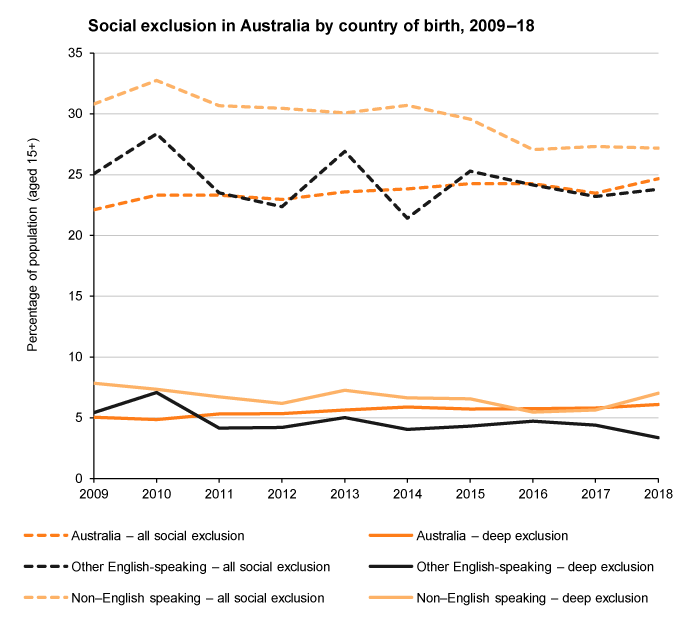Country of birth
In measuring social exclusion we found that immigrants from non–English speaking countries consistently experience more social exclusion than native-born Australians.
In 2018 (the latest data), 27% of these immigrants experienced exclusion compared with 25% of people born in Australia and 24% of immigrants from English-speaking countries.
The rate of deep social exclusion was 7% in 2018 for immigrants from non–English speaking countries, 6.1% for people born in Australia and lower for immigrants from English-speaking countries (3.4%).
Over the period 2009 to 2018, the gap between the social exclusion of people born in Australia and of those born overseas has narrowed.
In the graph below, the ‘all social exclusion’ lines show the total of marginal social exclusion and deep social exclusion.

| 2009 | 2010 | 2011 | 2012 | 2013 | 2014 | 2015 | 2016 | 2017 | 2018 | |
|---|---|---|---|---|---|---|---|---|---|---|
| All social exclusion | ||||||||||
| Australia – all social exclusion | 22.1 | 23.3 | 23.3 | 23 | 23.6 | 23.8 | 24.2 | 24.3 | 23.5 | 24.7 |
| Other English-speaking – all social exclusion | 25.1 | 28.4 | 23.5 | 22.4 | 26.9 | 21.4 | 25.3 | 24.1 | 23.2 | 23.8 |
| Non–English speaking – all social exclusion | 30.8 | 32.7 | 30.7 | 30.5 | 30.1 | 30.7 | 29.6 | 27.1 | 27.3 | 27.2 |
| Deep exclusion | ||||||||||
| Australia – deep exclusion | 5.1 | 4.9 | 5.3 | 5.4 | 5.6 | 5.9 | 5.7 | 5.7 | 5.8 | 6.1 |
| Other English-speaking – deep exclusion | 5.4 | 7.1 | 4.2 | 4.2 | 5 | 4 | 4.3 | 4.7 | 4.4 | 3.4 |
| Non–English speaking – deep exclusion | 7.8 | 7.3 | 6.7 | 6.2 | 7.3 | 6.6 | 6.6 | 5.5 | 5.6 | 7 |
About the social exclusion monitor
The social exclusion monitor is the work of the Brotherhood of St. Laurence and the Melbourne Institute of Applied Economic and Social Research (MIAESR). This page was updated using analysis of Wave 18 of the HILDA Survey in October 2020.